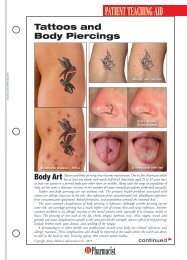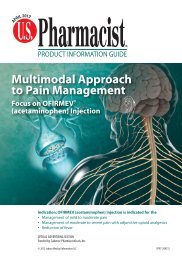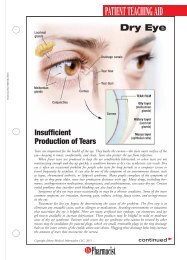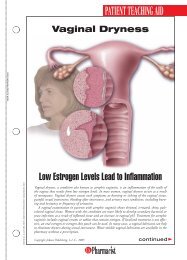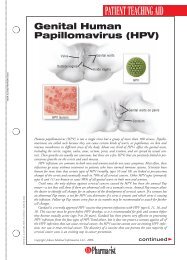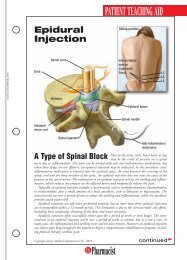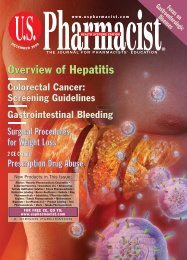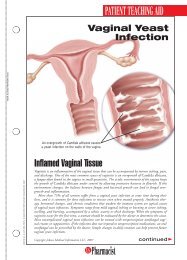View PDF Edition - U.S. Pharmacist
View PDF Edition - U.S. Pharmacist
View PDF Edition - U.S. Pharmacist
Create successful ePaper yourself
Turn your PDF publications into a flip-book with our unique Google optimized e-Paper software.
TrendWatchAcute Negative FeelingsAmong AdultsThe 2007 NationalHealth InterviewSurvey for noninstitutionalizedadults provides anunderstanding ofthe prevalence ofacute feelings ofsadness, hopelessness,worthlessness,or nervousness orthat everything isan effort.Sadness, Hopelessness,Worthlessness,or EverythingFeeling Likean Effort: Tenpercent of respondentsexperiencedsadness; 6% felthopeless; 5% feltworthless; and 13% feltthat everything was aneffort. Twelve percent ofwomen felt sad, comparedwith 8% of men.More non-Hispanicblack respondents thannon-Hispanic whiterespondents felt thateverything is an effort.The highest percentageof respondents withthese feelings had lessthan a high-schooldiploma, and respondentsleast likely to haveSomnath Pal,BS (Pharm), MBA, PhDProfessor of PharmacyAdministration, College ofPharmacy & Allied HealthProfessions, St. John’s University,Jamaica, New YorkWorthlessnessHelplessnessRestlessnessSadness“Everything isan effort”NervousnessPrevalence of Selected Acute Negative Feelings2.93.75.26.73.17.94.210.13.04.92.63.57.33.97.42.79.6these feelings had atleast a bachelor’s degree.Adults in poor familieswere twice as likely asadults in families thatwere better off to feelsad, hopeless, worthless,or that everything is aneffort.Among respondentsunder age 65 years, 25%of those with Medicaidcoverage experiencedfeelings of sadness, comparedwith 15% of thosewho were uninsured and6% of those who hadprivate health insurance.Among individuals aged65 years and over, 19%of those with Medicaidand Medicare coverageexperienced feelings of3.10 5 10 15 20 25 30 35 40Percentage of adults surveyed© JUPITERIMAGES7.97.98.47.57.418-44 years45-64 years65-74 years75+ years8.4sadness, compared with11% of those with onlyMedicare coverage and8% of those with privatehealth insurance.Divorced respondentswere more likely thanother respondents to feelsad or that everything isan effort.Feelings of Nervousnessor Restlessness: Thirteenpercent of respondentsexperienced nervousness,and 15% reported restlessness.Sixteen percentof women felt nervous,versus 11% of men.Non-Hispanic whiterespondents had morefeelings of nervousnessthan non-Hispanic blackrespondents. Thehighest percentageof adults withthese feelings hadless than a highschooldiploma;those least likelyto have these feelingspossessed abachelor’s degreeor higher. Adultsin poor familieswere more likelyto feel nervousthan adults infamilies that werebetter off.Among individualsunder age 65years, 26% ofthose with Medicaidcoverage experiencedfeelings ofnervousness, comparedwith 15% of those whowere uninsured and 12%of those who had privatehealth insurance. Amongadults aged 65 years andover, 25% of those withMedicaid and Medicarecoverage experiencedfeelings of nervousness,versus 11% of those whohad only Medicare coverageand 11% of thosewith private healthinsurance. Adults whowere married were leastlikely to have feelings ofnervousness or restlessness,compared withadults who weredivorced or separated,never married, or livingwith a partner.10U.S. <strong>Pharmacist</strong> • November 2009 • www.uspharmacist.com




